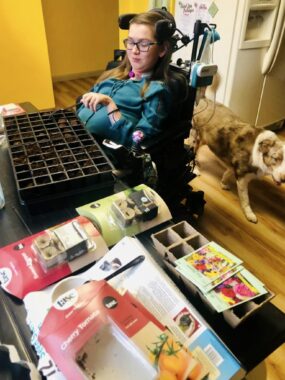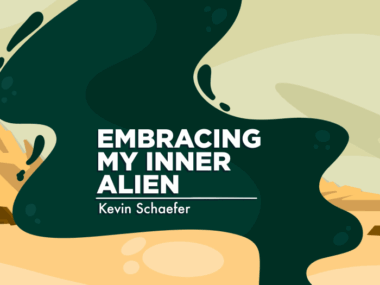Repurposing household objects helps me create disability hacks
Creative adaptation is key when living with SMA
Written by |

It seems there are hacks for everything now — little tips and tricks designed to help us get the most out of life while saving time, energy, or money. The internet and media are full of hacks for interior design, organization, cooking, budgeting, traveling, fashion, mindfulness, and just about anything else you can think of. Did you know there are even hacks for navigating life with a disability?
Eating utensil or gardening tool?
If you live in a climate with cold, snowy winters like I do, this might seem like an odd time to be thinking about gardening. Although the ground is frozen right now, thinking about the blooms and greenery that will grow in springtime gives me a reason to smile as I wait for the snow to melt. It also reminds me of an easy disability hack.
Last year, Mom and I began our planting inside while the weather was still chilly so that the flowers and vegetables could grow to be strong and healthy before they were moved outside. SMA causes contractures, fatigue, and atrophy in my hands that limit my ability to care for plants, but when Mom and I combine our abilities, we can both enjoy the activity.
Because I lack gross motor function, which is responsible for large movements like standing or raising an arm, it’s difficult for me to manipulate clunky gardening tools. Fine motor function controls more detailed, precise movements, which are easier for me. Both are affected by SMA, but because my fine motor capabilities are less compromised, I can help with things like sorting seeds and writing labels while Mom does the heavy lifting. We still found a way for me to dig through some dirt, though.

Halsey Blocher works hard at gardening with a fork to make a great space for flowers to grow by spring. (Courtesy of Halsey Blocher)
Many of our seeds were to be planted in a starter tray that came with dehydrated dirt in individual compartments. We simply needed to add water to rehydrate the soil before breaking it apart and burying the seeds. This is when Mom thought to hand me one of the plastic forks I’d normally eat with. Even after the dirt was softened by the water, I still needed a utensil to help break through it. The fork was lighter than the metal tools and allowed me to follow Mom’s watering can and churn some of the wet soil until I became too tired and she finished the job while I observed.
(In case you’re concerned, that fork was permanently repurposed into a gardening tool, and no one ate off it again.)
A sprinkle of creativity
If you’re not interested in gardening, perhaps you could test out some disability hacks while you bake instead. That sounds like a fun — and tasty — way to chase away the cold!
Again, I have limited physical ability to operate kitchen utensils and appliances, so my primary jobs when it comes to cooking or baking are reading the recipes and taste testing. Depending on my energy levels, I’ll sometimes help spoon in spices or do a bit of mixing. And when it comes to decorating, I’m always ready to add finishing touches with some sprinkles.
This still requires some creativity because the sprinkle canisters are heavy. But nobody said you can only pour them from their original container. I like to use a medicine cup. We have lots of those for measuring my liquid medications, and once someone transfers the sprinkles into the tiny cup for me, I can lift it and give a gentle shake to dust the tops of warm cookies and cupcakes with festive shapes and colors.
A community of inventive thinkers
It looks like I’m not the only one who repurposes household objects into clever hacks. In a column titled “Wondering How to Use a Syringe? It Makes a Good Life Hack,” my fellow SMA News Today columnist Brianna Albers shares how a medicine syringe got her out of a sticky situation.
Brianna normally takes medication and fluids through her feeding tube due to swallowing difficulties, but she can swallow some things. When an allergy pill became lodged in her throat, she needed a drink to wash it down, but there were no straws to be found. Her dad came up with the inventive solution of squirting water directly into her mouth with a syringe, which worked so well that they might continue using it instead of straws. Brianna writes, “The syringe was easy in comparison. I opened my mouth, and that was that. No sucking or positioning needed.”
The disability community is full of people who are masters of making adaptive items. We come up with these ideas because the tools to meet our unique needs don’t always exist. There’s usually someone else with similar challenges, though. Our hacks may be designed to make our lives easier, but sharing them often helps others, too.
What creative disability hacks do you find helpful? Please share them in the comments below.
Note: SMA News Today is strictly a news and information website about the disease. It does not provide medical advice, diagnosis, or treatment. This content is not intended to be a substitute for professional medical advice, diagnosis, or treatment. Always seek the advice of your physician or other qualified health provider with any questions you may have regarding a medical condition. Never disregard professional medical advice or delay in seeking it because of something you have read on this website. The opinions expressed in this column are not those of SMA News Today or its parent company, Bionews, and are intended to spark discussion about issues pertaining to spinal muscular atrophy.








Leave a comment
Fill in the required fields to post. Your email address will not be published.